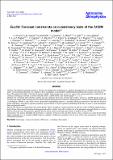Por favor, use este identificador para citar o enlazar a este item:
http://hdl.handle.net/10261/296738COMPARTIR / EXPORTAR:
 SHARE SHARE
 CORE
BASE CORE
BASE
|
|
| Visualizar otros formatos: MARC | Dublin Core | RDF | ORE | MODS | METS | DIDL | DATACITE | |

| Título: | Euclid: Forecast constraints on consistency tests of the ∧cDM model |
Autor: | Nesseris, Savvas; Martinelli, Matteo; García-Bellido, Juan CSIC ORCID; Tutusaus, Isaac CSIC ORCID; Fosalba, Pablo CSIC ORCID; Serrano, Santiago CSIC ORCID; Euclid Consortium | Palabras clave: | Dark energy Large-scale structure of the universe Cosmology: observations |
Fecha de publicación: | 2022 | Editor: | EDP Sciences | Citación: | Astronomy and Astrophysics 660: A67 (2022) | Resumen: | [Context] The standard cosmological model is based on the fundamental assumptions of a spatially homogeneous and isotropic universe on large scales. An observational detection of a violation of these assumptions at any redshift would immediately indicate the presence of new physics. [Aims] We quantify the ability of the Euclid mission, together with contemporary surveys, to improve the current sensitivity of null tests of the canonical cosmological constant Λ and the cold dark matter (ΛCDM) model in the redshift range 0 < z < 1.8. [Methods] We considered both currently available data and simulated Euclid and external data products based on a ΛCDM fiducial model, an evolving dark energy model assuming the Chevallier-Polarski-Linder parameterization or an inhomogeneous Lemaître-Tolman-Bondi model with a cosmological constant Λ, and carried out two separate but complementary analyses: a machine learning reconstruction of the null tests based on genetic algorithms, and a theory-agnostic parametric approach based on Taylor expansion and binning of the data, in order to avoid assumptions about any particular model. [Results] We find that in combination with external probes, Euclid can improve current constraints on null tests of the ΛCDM by approximately a factor of three when using the machine learning approach and by a further factor of two in the case of the parametric approach. However, we also find that in certain cases, the parametric approach may be biased against or missing some features of models far from ΛCDM. [Conclusions] Our analysis highlights the importance of synergies between Euclid and other surveys. These synergies are crucial for providing tighter constraints over an extended redshift range for a plethora of different consistency tests of some of the main assumptions of the current cosmological paradigm. |
Descripción: | Euclid Consortium: S. Nesseris et al. | Versión del editor: | https://doi.org/10.1051/0004-6361/202142503 | URI: | http://hdl.handle.net/10261/296738 | DOI: | 10.1051/0004-6361/202142503 | E-ISSN: | 1432-0746 |
| Aparece en las colecciones: | (ICE) Artículos (IFT) Artículos |
Ficheros en este ítem:
| Fichero | Descripción | Tamaño | Formato | |
|---|---|---|---|---|
| forecastmodel.pdf | 2,06 MB | Adobe PDF |  Visualizar/Abrir |
CORE Recommender
SCOPUSTM
Citations
11
checked on 03-abr-2024
WEB OF SCIENCETM
Citations
8
checked on 28-feb-2024
Page view(s)
43
checked on 18-abr-2024
Download(s)
14
checked on 18-abr-2024
Google ScholarTM
Check
Altmetric
Altmetric
NOTA: Los ítems de Digital.CSIC están protegidos por copyright, con todos los derechos reservados, a menos que se indique lo contrario.
